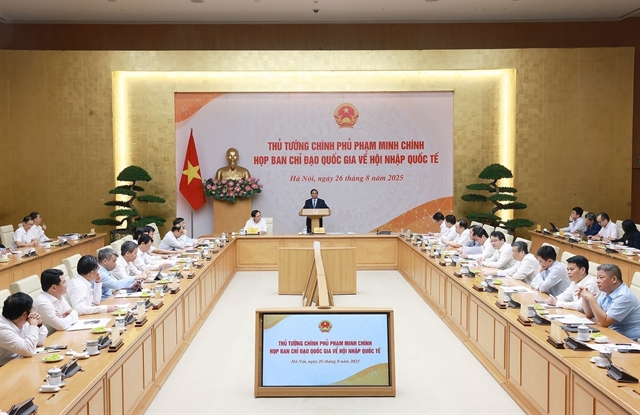 Environment
Environment

Climate change has gained recognition as an imminent danger, but the threat to existing fresh water resources requires more immediate attention.
  |
Trinh Thanh Thuy, Editor in Chief of Viet Nam News |
Climate change has gained recognition as an imminent danger, but the threat to existing fresh water resources requires more immediate attention.
The United States and China won much world acclaim when they formally ratified the Paris agreement to curb climate-warming emissions on Saturday.
Contributions by these powers, which account for nearly 40 per cent of global emissions, is a promising sign that the pact can take effect before the end of the year.
Fifty-five nations covering at least 55 percent of global emissions need to formally ratify the treaty for it to become legal.
While world attention in the last few decades has been more focused on implementing the United Nations Framework Convention on Climate Change (UNFCCC), a non-binding agreement, other international laws governing the efficient and harmonious use of existing resources have been neglected.
One such law, the Convention on the Law of the Non-Navigational Uses of International Watercourses, adopted by the UN National Assembly in 1997, has been ratified by just 36 countries. Neither the US nor China are among them.
Viet Nam is the only Southeast Asian country that has ratified the convention.
Equitable sharing
The document requires participatory UN member states to consider the impact of their actions on other states with an interest in a water resource (like the Mekong River, for instance), and to equitably share the resource, mindful of variant factors like population size and availability of other resources.
Member states are required to provide information to other states about the condition of their shared watercourse and about their planned uses for it, allowing sufficient time for consideration and objection if the use is perceived to be harmful.
The convention also requires member states to negotiate a mutually acceptable solution if a use is perceived to be harmful, or seek arbitration at international organizations such as the International Court of Justice.
There are also provisions on reasonable damage control, with states obligated to take remedial steps and/or compensate for losses caused to other states. Other provisions deal with managing natural damage to waterways, such as those caused by drought or erosion.
More urgent
Reports presented last month at the Global Water Conference 2016 said 780 million people in developing countries lack access to clean water and 3.4 million people die each year from water-related diseases. Every 20 seconds, a child dies from a water-related disease.
While clean water is a crucial factor in improving sustainable food production and reducing poverty and hunger, more than 80 per cent of sewage in developing countries is discharged untreated, polluting rivers, lakes and coastal areas.
It is also projected that by 2025, the proportion of the world’s population living in water-stressed countries will increase by two thirds.
A World Bank report, “High and Dry: Climate Change, Water and the Economy,” concludes that limited and erratic water availability reduces economic growth, induces migration, and ignites civil conflict, which fuels further potentially destabilising migration.
Water sources have even been held hostage for evil purposes, such as the reported use of Taqba Dam in Syria by the Islamic State earlier this year.
Downstream crises
In Southeast Asia, drought and salination caused by harsh weather and alleged water storage at dozens of upstream dams on the Mekong River bankrupted about 1.5 million farmers in Viet Nam.
For five years now, Mekong Delta farmers have suffered from the absence of regular flooding that helps fertilise the delta, killing pests and bringing an abundance of seafood. Communities here have suffered declining fisheries and the change in water levels has seriously affected their livelihoods.
Increasing sea water intrusion as an effect of climate change has destroyed millions of hectares of crops and permanently altered the nature of many land areas.
Experts worry that the diversion of Mekong waters by Thailand and Cambodia to other regions is also changing the water regime and the ecosystem in the delta.
They also say that the development or diversion of major trans-boundary rivers originating in Tibet, China, such as the Brahmaputra and the Mekong, can cause tensions in relations with China’s neighbours.
 |
| The canal system in Ca Mau Province fed by fresh water from the Mekong ran dry last April. VNA/VNS photo An Hiếu |
Forest destruction in catchment areas of local rivers and uncontrolled and overexploitation of groundwater for cash-crop cultivation, domestic and industrial use have also caused ground water levels to fall dramatically. Deforestation also results in more flash floods in lower regions.
Both local and cross-border contamination of water resources has also been reported more frequently over the last 20 years.
Last month, the chairman of Lao Cai, a province on the Viet Nam- China border, reported increasing levels of pollution in the Red River waters flowing in from China.
Riparian countries on the Mekong have blamed each other for several problems including water shortages, change in the river regime and degradation of the ecosystem. These have fueled nationalist sentiments and suspicions that found wide expression in social and mainstream media.
The Mekong River Commission (MRC), the only inter-governmental organisation that works directly with the governments of Cambodia, Lao PDR, Thailand and Viet Nam, and engages Myanmar and China as dialogue partners, has tried to facilitate joint management of shared water resources and sustainable development of the Mekong River.
However, emerging controversial issues such as dam building or river water diversion seem to have gone beyond its capacity.
The MRC has adopted a series of procedures for water quality, data and information exchange and sharing, water use monitoring, consultation and for maintenance of flows on the mainstream, but it lacks an effective dispute settling mechanism.
Furthermore, the procedures do not cover partners. Vietnamese officials have complained that the Chinese do not share their water level monitoring data during the dry season, making it difficult for them to plan water storage and use.
The riparian countries are now seeking to learn from other models in addressing trans-border challenges, like the International Commission for the Protection of the Danube River (ICPDR), an organization consisting of 14 member states and the European Union.
To cope with fresh water shortage, a series of measures have been applied recently by the Lower Mekong countries, including water diversion, building reservoirs, drip irrigation and digging wells to collect water at hill foot or sandy areas. However all these investments can go to waste if the downstream nations have no control over the source of water supply. Crops will wither and local residents will suffer.
Therefore effective collaboration among these nations is needed to manage water resources and deal with environmental, public health and other issues.
Potential solutions
Supplements to the convention can address the concerns of sharing states, allowing for joint exploitation of the water resources for tourism, transport or even hydropower generation.
They can also jointly develop regulations and invest in a regional water storage system.
Riparian nations can even consider compensating people in catchment areas to ensure they benefit from the preservation of forest and water sources.
An interesting example is the compromise reached by Russia, China and Mongolia for preserving the ecosystem of Baikal, the largest fresh water lake in the world.
Russia had been protesting this issue since 2014, when China pledged $1billion in credit to the Mongolian Government for building a hydropower plant on Selenga, one of the 300 rivers flowing into Baikal.
It feared the project would negatively affect the lake’s ecosytem, a view supported by UNESCO, which said a number of rare species of birds and fish could disappear.
Last June the three countries agreed to temporarily freeze the project to build an eco-corridor in the area. Earlier this year, President Putin wrote off Mongolia’s US$174 million debt and promised to consider reducing future tariffs charged on power sold to Mongolia, which amounts to $25 million a year.
The Paris agreement has shown that world nations can reach consensus on common threats to humanity. It also shows that major powers wield decisive influence. They should, therefore, take the initiative on preserving and sustainably using one of our most valuable and vital natural resources, fresh water.— VNS




